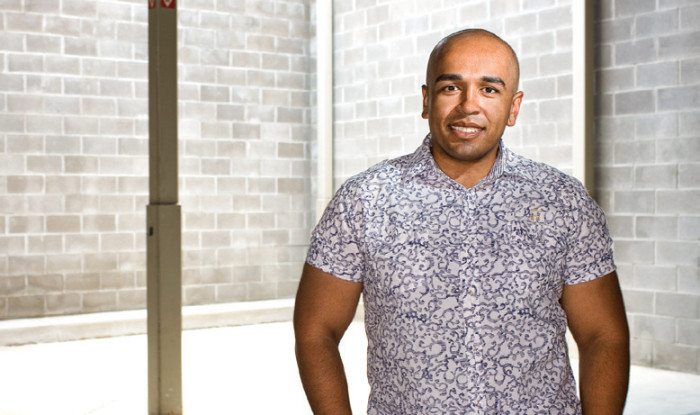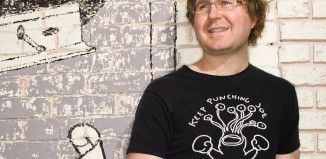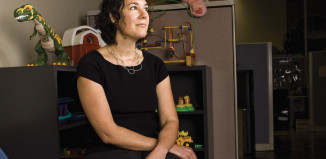Marques Harper is in the business of telling stories. And please, don’t worry that he might be judging your clothes, because he’s not.
This newspaperman, who covers fashion and style and writes a biweekly column for the Austin American-Statesman, has been on a unique journey to reach this point: more than three years after relocating to the Capital City, he’s in a comfortable and happy place both personally and professionally.
“Being gay is part of me, but people see that I’m a black man first,” Harper said. “It’s just one layer and they’re all layers of who I am.”
Discussing everything from his career and the roots of his lifelong struggle with his weight to coming out as a gay man and his feelings about Austin, Harper peeled back some of the layers, displaying a candor and sense of humor that’s rare when a journalist is the one being interviewed.*
 “My column isn’t about me. It’s about fashion and my journey in fashion,” Harper said. And who are his style icons? He listed Tom Ford, Madonna and Vogue creative director Grace Coddington.
“My column isn’t about me. It’s about fashion and my journey in fashion,” Harper said. And who are his style icons? He listed Tom Ford, Madonna and Vogue creative director Grace Coddington.
Jersey Roots
While these highly visible fashionistas play a big part in delineating Harper’s current work, his initial foray into writing was inspired by influences closer to home. An essay that Harper wrote in the fifth grade stands out as the time he first dove into writing. The topic was his mother and the fact that she’d been diagnosed with multiple sclerosis. Born to working-class parents (his mom was a copy editor and his dad a truck driver), he got his start in newspapers during high school working for The Burlington County Times, the local paper in Willingboro, New Jersey, not far from where he grew up in Westampton. In those pre-internet days, layouts were done with X-ACTO knives and early, black-and-white Macintoshes. While his friends were holding down jobs at the mall, Harper was a clerk in the paper’s sports department, working late nights and doing homework afterward.
His first year at Rutgers University in New Brunswick was an adjustment, in terms of learning about gay life on campus and also being in a more diverse environment. The pull of print was hard to resist, however, and he was soon working at The Daily Targum, the student-run newspaper at the university. With fees deducted from students’ term bills and advertising revenue, the paper was run just like the city’s newspaper. Harper would go on to land internships at The Atlanta Journal-Constitution, The Oregonian and at The New York Times’ bureau in Trenton.
Harper knew he was gay from a very young age. In the seventh grade, he penned a short story about a man who contracts HIV through a blood transfusion. Harper came out to his parents, who have always been supportive, over the course of two dinners many years ago.
“I think my parents are just happy that I’m pursuing what I love,” said Harper.
When Harper’s mother was diagnosed with multiple sclerosis in 1985, his family life changed. That event forced him to grow up fast and also had a long-lasting emotional and physical impact.
“I’ve had to be really strong,” he said. “There were times when I was very young, in fourth grade or something, making dinner or doing laundry. It’s what had to be done to make my family situation work.”
Pennsylvania to Austin
Harper’s parents instilled in him the value of living a fully independent life and gave him the freedom to do so, even when that meant moving far away from where he grew up. The post-college job search landed Harper in Wilkes-Barre, Pennsylvania, where he wrote for The Times Leader about business, a topic he initially knew nothing about. Later, he switched to arts and leisure and got the chance to interview Joan Rivers and Ellen Degeneres.
In 2006, he moved to Roanoke, Virginia, once again going to an unfamiliar place for work. his position at The Roanoke Times set the stage for his role at the Statesman today, since he covered television, radio, pop culture, fashion and the zoo. “And of course, the year I cover the zoo all hell breaks loose,” he said, laughing. “At one point a monkey actually escaped.” It was also where he got television experience while working on the paper’s Timescasts.
After he saw the opening for the fashion position, he went for it. Eighteen months later, he landed in the lone star state, and he hasn’t looked back. “People are in those jobs for years, so this was my one shot at becoming a fashion writer,” he said, noting that he flew down to Austin on a Thursday in January of 2007 for a round of interviews. By the following Monday, he was offered the job and he moved here in March.
Countless columns, photo shoots and blog posts later, one story that he loved is a longer piece he wrote last summer about Blackmail boutique owner Gail Chovan. The piece was a tough one to write because he personally knew Chovan, who was in the midst of battling breast cancer. Chovan’s mother and sister were also diagnosed with breast cancer around the same time.
“I had to step into her life and meet with her while she was going through her treatments,” Harper said. “I was with her on some of her tough days. It was a challenge to condense it all into something readers would understand but that still had a passion to it.”
30-something
Keeping up your image as a fashion columnist and writer can be tough aside from producing photoshoots and churning out copy, there’s a certain pressure to maintain a stylish appearance and always look fabulous. “My goal is to help people look their best. If you look your best, you’re going to do good things in the world. It’s important to care about yourself so that you’re in a place to care about others.”
 Prior to his mother’s MS diagnosis when he was in the second grade, Harper had been skinny. Learning early on that food can bring comfort and temporarily heal the feelings of stress, his eating habits were a manifestation of the emotional turmoil over his mother’s illness and the fact that she almost died in a deadly car accident in January of 1992.
Prior to his mother’s MS diagnosis when he was in the second grade, Harper had been skinny. Learning early on that food can bring comfort and temporarily heal the feelings of stress, his eating habits were a manifestation of the emotional turmoil over his mother’s illness and the fact that she almost died in a deadly car accident in January of 1992.
Harper’s mother lost control of the car–in the days before airbags–and the only thing that stopped the car was a telephone pole. “Everything was in slow motion,” he said. “I still remember the blood on the car seat, and I still remember thinking I had to stay calm because I had to get us help. I didn’t have a complete emotional collapse until I saw my extended family at the hospital.” His mother had to have plastic surgery and wouldn’t return home from the hospital until late that spring.
“I remember wondering if multiple sclerosis, which would reshape my family as I knew it, would cause my mom to die then,”
Harper said, adding that the emotion is still raw now, more than two decades later. “While I had a discussion with my parents about MS and what was going on with my mom, I just thought she’d be gone.”
His initial attempt at a lifestyle change was due to a work assignment at The Times Leader. He did a series called “30 Days,” in which a reporter would pick something to change or do in 30 days. He wanted to see how much weight he could lose. By changing his diet and doing daily two-hour workouts, he dropped about 25 pounds. This led him to take up bodybuilding, and he ended up placing third in the Mount Rogers Drug Free Bodybuilding & Fitness Figure Championships in 2006. Even so, Harper knew that after all of that deprivation he would fall back: “I started eating ice cream. I was obsessed with pumpkin and egg nog ice cream.”
The past two years he’s dealt with some tough health issues. After a bit of investigative journalist research that was prompted by a piece he read in O: The Oprah Magazine about Winfrey’s struggle with her weight, he discovered the problem. Like many people, he’s vitamin D deficient; in his case, that deficiency led to thyroid issues. Throw in a few bad romances and other life stress, and Harper estimated that he gained about 50 pounds since moving to Austin in 2007. Now that the vitamin D issue is being corrected, he’s making another major change. “I think my clothes will thank me,” Harper said. “I can’t wait to get back into my favorite clothes.”
A designer in town recommended a program that her health coach is involved with and Harper started it in early April. The program consists of certain premade low-calorie meals each day along with one he cooks himself consisting of a protein and a vegetable. He’s also not eating any carbs or drinking alcohol. At this point, he’s lost over 30 pounds and hopes to lose 25 more–but more importantly, he no longer uses food to deal with emotional stress.
As with any discussion of image, the conversation eventually turned to dating and relationships. “At this point I haven’t had much success here,” Harper said. “It’s a challenging town to connect with the right person.” Although he’s open to dating if the right guy comes into his life, he’s not focused on it.
Currently at work on a nonfiction book about fashion, Harper is hopeful about his future and said there’s a lot more to accomplish in Austin.
“I’ve learned to deal with my emotions and not attach them to what’s on my plate,” Harper said. “At the end of the day, I’m just trying to live my truth as best I can.”




































